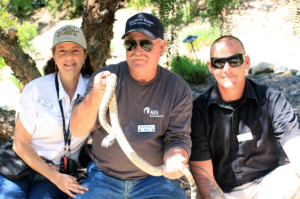Train your dog to avoid rattlesnakes – June 1

Train your dog to avoid rattlesnakes
- What: Rattlesnake Avoidance Training for Dogs
- When: Saturday June 1, 2013 9a.m. – 6p.m.
- Where: Private residence in Paso Robles (Address provided on paid registration)
- Cost: $95 per dog; reservations required. Space is limited;
- Register: Go to www.MANPAW.com Call Gina Gables at 523-3432.
In one short session a dog can be trained to avoid rattlesnakes. A course on rattlesnake avoidance training for dogs – featuring live rattlesnakes that have been disabled from biting at a private facility in Paso Robles, Ca.
The course will be led by Gina Gables, owner of Ma & Paw Kennel Canine Training Services and professional dog trainer for more than 20 years. The rattlesnake expert Steve Gardner is a graduate from the University of California at Riverside with a Bachelor of Science Degree in Herpetology and has 28 years of experience as a Wildlife Ecologist and Herpetologist. Steve’s assistant John Gardner who also happens to be his son, is a biological field assistant/monitor certified by U.S. Fish and Wildlife Services with 12 years of field experience.
Gina personally trains every dog to recognize and avoid the scent, sound or sight of rattlesnakes it becomes aware of. During each dog’s individual training session, Gardner and Gables will use live rattlesnakes that have had their mouths muzzled to prevent them from biting.
“Our first priority is the comfort and safety of all involved. This includes your dog and the snakes as well as the humans,” said Gables of Simi Valley. Gina specializes in obedience training and problem-behavior modification with dogs. Gina’s experience and sensitivity allows the dogs to be humanely treated during the training process.
The training will take place in a controlled environment, using remote training collars adjusted to each dogs’ individual temperament, personality and physical response characteristics. The device “delivers an uncomfortable stimulation to the dog when the dog has been alerted to the presence of the snake, whether it be by smell or sound or sight. We do this so the dog will be able to avoid any of these clues to a rattlesnake’s presence individually even if the other clues aren’t present.”
For instance, “your dog may be downwind of the rattlesnake and can smell it but is not able to see it; and the snake – possibly not being aware of the dog’s presence – may not be giving a warning rattle,” Gables explained. “The dog, by avoiding just the smell, would avoid the rattlesnake. If the owner is observant of the dog’s behavior, he or she can possibly prevent themselves or others from being bitten as well.”
Each dog is assigned a timeslot and individual training sessions will be given throughout the day. They offer shock, spray or vibrating collar which allows us to train dogs as young as 8 weeks which are too young to use shock collars but are certainly old enough to learn.
They hope that by taking part in this training the dog as well as the owner will be spared the pain and distress (as well as the considerable expense) caused by the dog becoming a victim of a rattlesnake bite.
–By Gina Gables























